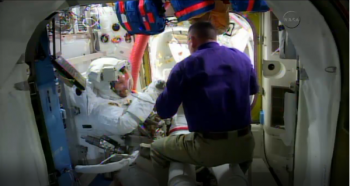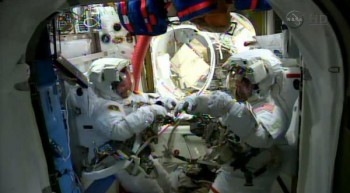Before the Alexander and Reid head out into deep space they ‚prebreathe“ to purge their bodies of nitrogen.
Inside the International Space Station the astronauts live in air at pressures similar to on Earth. Outside their is no air pressure so astronauts wear spacesuits to keep safe. Operating a spacesuit at normal air pressure is impractical as it creates large pressure differences between inside the spacesuit and the vacuum of space. Just as passenger jets operate at reduced air pressure, so do the spacesuits Alexander and Reid are wearing. By reducing the pressure differences between inside and outside both jumbo jets and spacesuits don’t need to be so heavy and cumbersome to withstand the pressure. For the astronauts the lower pressure also makes it easier to move their arms and legs in the spacesuit.
The disadvantage to working in lower pressure is that as you transition from high to lower pressure is that the normal nitrogen in your blood can form dangerous bubbles inside. This is a very serious condition known as decompression sickness or ‚the bends‘. Scuba divers are at risk as they return to the sea surface after spending time deep underwater (at high pressure compared to sea level). Astronauts go through a similar process, leaving their higher pressure environment inside the Space Station to the lower pressure spacesuit.
 An effective way to stop the nitrogen from causing problems is by removing it altogether. This is what Alexander and Reid are doing right now. By breathing pure oxygen for two hours their bodies will no longer have any nitrogen. The astronauts do some light exercise to help speed up the process as well as continue preparing for the spacewalk.
An effective way to stop the nitrogen from causing problems is by removing it altogether. This is what Alexander and Reid are doing right now. By breathing pure oxygen for two hours their bodies will no longer have any nitrogen. The astronauts do some light exercise to help speed up the process as well as continue preparing for the spacewalk.





Discussion: 8 comments
Why is it I hear breathing 100% oxygen is bad for you, there should be at least some nitrogen in the mix like a minimum of 20%. Many emergency masks have a hole in it to admit outside air to dilute the pure oxygen. Some mild hyperberic chambers have a mask so the people inside can dilute the pure oxygen by breathing regular air at intervals.
Is it something to do with pilots and astronauts already in a place with less pressure than 14.7 PSI ?
Tony, this is due to the potential for oxygen toxicity. You learn about it in the nitrox class when doing advanced scuba dive training.
https://en.wikipedia.org/wiki/Oxygen_toxicity
https://www.sportdiver.com/what-is-oxygen-toxicity
Interesting information. Thanks for sharing. I’m also Nitrox certified. I remember that information. The prebreathing is done at sea level pressure for about two hours, to purge the body of nitrogen, the gas that can cause the bends (decompression sickness). The space suits they use are NOT pressured at sea level. At a lower pressure but I don’t know the exact figure. Decompression sickness would be hard to treat in space as I don’t believe the space station is equipped with a hyperbaric chamber. I could be wrong on that … but I don’t believe they have one.
I was actually mistaken. There IS a hyperbaric chamber on the International Space Station, along with two airlocks which can be pressured. Those could be useful!
https://www.sae.org/publications/technical-papers/content/921142/#:~:text=The%20Space%20Station%20Airlock%20has,equipment%20to%20support%20hyperbaric%20operations.
Oxygen at sea level is much less of a problem than hyperbaric (high pressure) oxygen. If I remember my dive training and EMT class material correctly, I believe at over two atmospheres, oxygen can be toxic. This is one of the reasons that oxygen is only breathed intermittently in a hyperbaric chamber. It can be a problem at sea level as well, but takes MUCH longer to create problems. The oxygen being breathed by the astronauts prior to a spacewalk is to purge the body of nitrogen, to make a case of the bends much less likely. They breathe pure oxygen at sea level (14.7psi) for something like two hours … not long enough to create problems. The bends is treated in a hyperbaric chamber which I do not believe a spacecraft is equipped with. They’re required equipment aboard oil rigs and other commercial diving operations.
There’s a chamber on the International Space Station … the two airlocks can be pressured and used for hyperbaric treatment if needed. The article above summarizes it but you’d have to pay for the full article. I did not.
Kindly post me any reply
https://www.sae.org/publications/technical-papers/content/921142/#:~:text=The%20Space%20Station%20Airlock%20has,equipment%20to%20support%20hyperbaric%20operations.